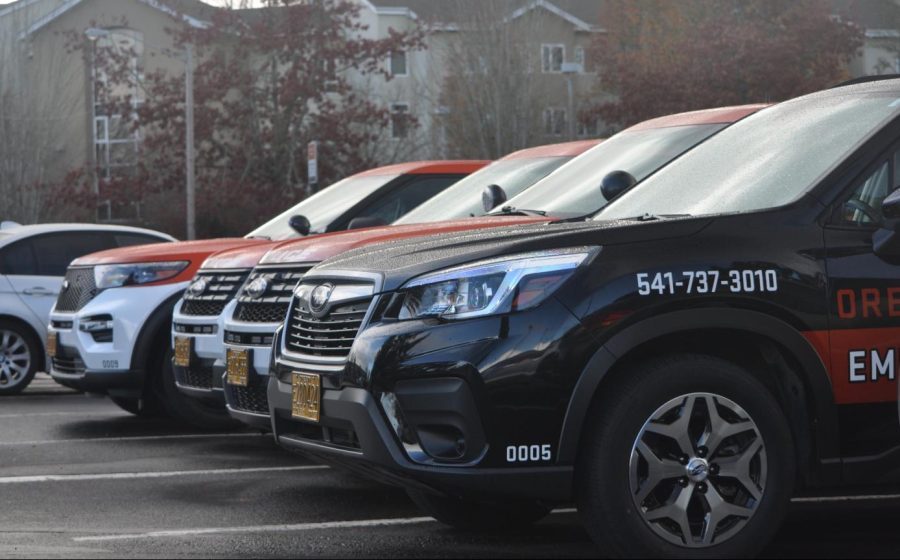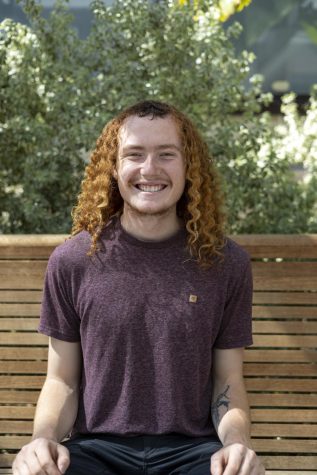Oregon State University police department was created to ‘utilize the education mission and values of OSU’
Oregon State University public safety department cars are lined up outside Kerr Administration in November of 2021. Anyone with information on the incident is urged to contact OSU DPS at 541-737-3010.
February 10, 2022
After Oregon State University created its own police department in January 2021, the new department had advanced police reform, but some students don’t think reform is enough.
According to Steve Clark, the vice president of University Relations and Marketing, the university is open to listening to student concerns and wants to continue to increase diversity and bias training in its police force.
Clark said OSU has had licensed law enforcement for over 50 years. This was originally from the Benton County sheriff’s office but moved to Oregon State Police in the 80s. In 2019, OSP ceased their contract and on Jan. 1, 2021, the OSU Police Department started under the leadership of Shanon Anderson, the associate vice president for public safety and OSU chief of police.
“The decision by the OSU Board of Trustees and President Ed Ray at the time to create our own licensed law enforcement was to not emulate any licensed law enforcement department… but to utilize the educational mission and values of OSU as the foundation for what we do in public safety,” Clark said.
According to Clark, the university is continually getting better at addressing racism and advancing diversity, equity and inclusion, but is never satisfied with the way racism is addressed in the community.
“The point I would make is that we will listen to and seek to understand what our community members feel, and we will continue to work to improve those matters,” Clark said. “We have a bias response team at the university. We acknowledge that there are issues that are historically prevalent in society, in Oregon, in some Oregon communities, and certainly within policing—we’re not ignoring those, we’re addressing those.”
According to Clark, there is a website available for OSU community members to file a complaint, offer feedback, or reach out to the department in non-emergency situations.
“Shanon has made the OSU department of public safety and the work of her public safety officers and police officers very, very visible and very community based, Clark said. “The university has committed to a presence and purpose that is about the mission and values of OSU and the university community.”
According to the OSU public safety website, Anderson has advanced police reform initiatives and conducted bias training for police officers. She worked for the Seattle Police department from 1992 until she started working for OSUPD.
In 2011, the Department of Justice found the Seattle Police Department had a “pattern or practice of constitutional violations regarding the use of force that result from structural problems, as well as serious concerns about biased policing.”
In 2012, the Seattle Police Department was put under a federal oversight called a “consent decree,” which is a settlement agreement resolving a dispute between two parties without an admission of guilt or liability.
“I hope [people] would recognize that I myself was not at every call, and that I didn’t make all of the decisions for the Seattle Police Department,” Anderson said. “I took the opportunity to learn a lot. I’m very grateful for my experiences and for the people who mentored me. Chief Cordner is one of the instrumental chiefs from Seattle, and worked on the monitoring team and on the consent decree.”
Anderson said she supported reform initiatives at the Seattle Police Department, such as examining 911 calls to determine how they can apply the necessary resources differently for future action.
However, according to Ines Mbousya, a biohealth sciences student and the current president of the Black Student Union, police reform is not enough.
“I think [the police system] should completely be dismantled, honestly, and rebuilt,” Mbousya said. “When I hear reform, especially when it comes to policing and stuff, I hear “Let’s tweak this thing here and this thing there and let’s lower the numbers,’ but what I want to see is where it’s zero to none, literally. I don’t want to hear every single day [that] there’s another incident. The system was definitely put in place to suppress people of color, definitely to incarcerate them, to keep them in a continuous loop of poverty.”
Public safety is complicated, according to Anderson, because many things frequently dealt with are implicit biases.
For example, Anderson said she is working to partner with Student Conduct and Community Standards on situations where, instead of putting a student into the criminal justice system, the student can instead go through SCCS. If there is a lack of cooperation from the student, then the case can go back to the justice system.
“There are still certain parts of policing that look very similar,” Anderson said. “It’s going to take some time to see differences because the criminal justice system is very complex. It’s not just what you see on the streets, but there’s a lot of other partners involved in it, and working together with them for how we can reform the system is very important.”
When the Black Student Union was doing a mental health walk last year, Mbousya said police officers from the OSUPD stopped to ask what was going on. According to Mbousya, the students were alarmed, but Anderson reassured the students that the police officers were only there to help.
“It kind of took us by surprise because I don’t think I’ve ever seen a police officer go up to Black students and necessarily say that,” Mbousya said. “They never really go out of their way. When she left, we were kinda just taken aback… When we realized her approach was on a friendly note, we all sort of eased.”











































































































